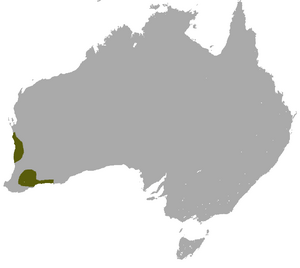White-tailed dunnart facts for kids
Quick facts for kids White-tailed dunnart |
|
|---|---|
| Conservation status | |
| Scientific classification | |
 |
|
| White-tailed dunnart range |
The white-tailed dunnart (Sminthopsis granulipes), also known as the ash-grey dunnart, is a small dunnart from Australia. It is a type of marsupial that looks a bit like a mouse.
Contents
How It Got Its Name
Scientists give every animal a special name. The white-tailed dunnart's scientific name is Sminthopsis granulipes. This name was given by a scientist named Ellis Troughton in 1932. Even though another scientist, Gerard Krefft, had described it earlier, Troughton's name became the one everyone used. So, to avoid confusion, scientists decided to keep Sminthopsis granulipes as its official name.
What It Looks Like
The white-tailed dunnart is a small animal. Its head and body are about 70 to 100 millimeters (about 3 to 4 inches) long. Its tail is a bit shorter, measuring 56 to 68 millimeters. These dunnarts weigh between 18 and 35 grams, which is about the same as a few quarters.
Their fur on top is a light fawn (light brown) color. This color blends smoothly into the white fur on their belly. Their feet and tail are a pinkish-white color. You can tell them apart by their tail, which is shorter than their body. The tail is also wider at its base. There's a thin brown stripe along the top of their tail. The bottoms of their back feet have a special bumpy texture.
Where It Lives
This small dasyurid (a type of marsupial) lives in two different areas of Western Australia. One area is east of Perth, in a region called the Goldfields. The other area is north of Perth, between Kalbarri and Jurien Bay.
White-tailed dunnarts like to live in coastal heathlands. These are areas with low, shrubby plants near the coast. They also live in sparse or dense shrublands. Sometimes, these areas have mallee eucalypt trees, which are a type of eucalyptus tree that grows with many stems from the ground.
Life and Habits
We don't know a lot about how white-tailed dunnarts behave or how they raise their young. However, we do know they are most likely nocturnal. This means they are active at night and sleep during the day.
They usually have their babies between June and August. The young dunnarts are then weaned (stop drinking milk from their mother) by October.
What It Eats
The white-tailed dunnart mainly eats insects that live on the ground.
- Groves, Colin (16 November 2005). Wilson, D. E., and Reeder, D. M. (eds). ed. Mammal Species of the World (3rd edition ed.). Johns Hopkins University Press. pp. 34. ISBN 0-801-88221-4. http://www.bucknell.edu/msw3.
See also
 In Spanish: Ratón marsupial de cola blanca para niños
In Spanish: Ratón marsupial de cola blanca para niños


